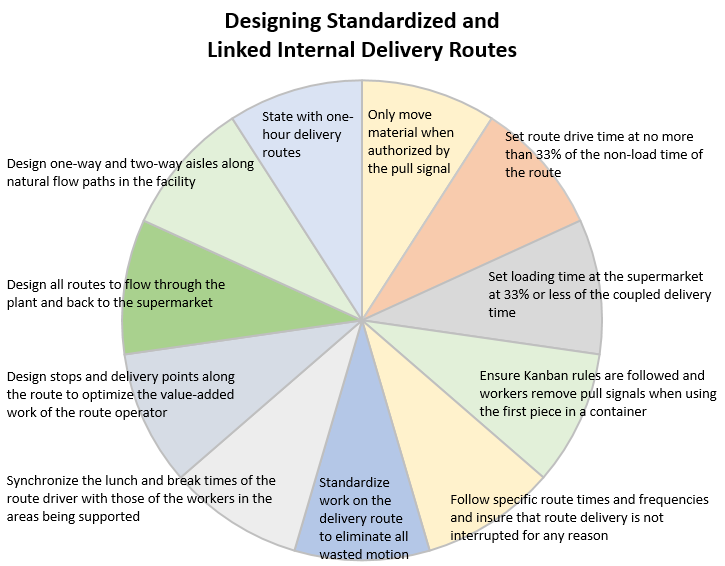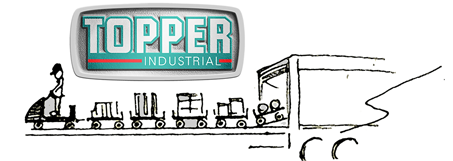The Topper Industrial manufacturing team understands that Lean logistics ensures material flows in and out of the production facility smoothly. Lean must be applied to the material replenishment function. Because Topper applies these principles to their own manufacturing process, they work with their customers in supporting their Lean initiatives. Recently Topper profiled the three major steps to implementing a Lean logistics system. (insert blog link posting url.)
Thinking beyond the pilot line for the PFEP (Plan for Every Part) when designing the parameters of the database is essential. Some other value streams may require data that are not reflected in the pilot line. Even if there are blank areas in the data, it is better to begin with a comprehensive database as possible.
Just as in one-piece flow, the goal is to use the smallest possible measure for each item. Use the smallest increments of measure, such as pounds versus tons, and inches instead of feet. Assign a PFEP Manager for each value stream, from the Production Control department. This is the only person who can update or change items in the PFEP. Keep the control for changes in as few hands as possible to avoid errors.
The next step in the Lean logistics conversion is to create a purchased parts supermarket. Once all materials and information for the smooth flow of the target area have been gathered, supermarket can be created.
With a proper Lean assessment, manufacturers must remember to leave space around the value-added production cells for supermarkets. The closer the supermarket can be to the point-of-use, the less motion and transportation waste there will be, and the more closely linked the Lean logistics system will be. The aim is to have a system that behaves like the autonomous nervous system, able to react to signals (pull) quickly.
In many cases materials are moved off of the truck, placed in temporary storage, paperwork processed or inspected, then moved before it reaches the final destination (point-of-use). This is waste that the Lean logistics conversion aims to eliminate. As much as possible, design material and information flow so that it goes from truck to supermarket without stopping.
As the material travels from the supplier to the point-of-use, count how many times it is put down or picked up. The ultimate aim of Lean logistics is to touch the parts as few times as possible; the net savings is a reduction in total cost to both manufacturers and suppliers by eliminating any interim storage locations, depots, and staging areas. The sizing of the supermarket is based on the maximum inventory levels of each part. Determine the maximum usage for each part to support normal operations.
Planned Maximum Inventory = Daily Usage x Shipment size (days usage) x Purchased Parts Buffer (days usage)
Base the sizing of the supermarket on the maximum usage for each part to support normal operations. In practical terms, this means determining the average usage of each part at the target site (cell, line, etc.). This information allows manufacturers to determine the maximum inventory required for each part.
The daily usage and shipment size factors are found in the PFEP database. This will allow companies to determine the purchased parts buffer, through a combination of variables such as:
Supplier issues:
- Quality performance
- Delivery performance
- Distance to the supplier
Carrier issues:
- Transportation reliability
- Uncontrollable factors such as weather
Internal issues:
- Fluctuation in customer demand or daily usage
Supplier Rating System
Use a supplier rating system, a carrier rating system, and history of internal demand variation to set a safety buffer. Important factors to consider are the number days’ supply of inventory required to buffer for weather-related delays, sudden production swings, and line stops due to supplier quality or delivery problems.
- Set minimum and maximum inventory levels for all parts in the supermarket
- Locate the purchased parts supermarket close to the receiving dock
- Identify the point of use address on the storage location for the items in the supermarket
- Simplify handling of containers (use flow racks, etc.)
- Create an overflow area in a highly visible place

by Chris Mosby
Chris Mosby, LSSMBB is the Lean Manager for Topper Industrial. Mosby has been a Lean/Six Sigma trainer for more than 20 years in multi-faceted, fast paced manufacturing environments. His experience includes management assignments in Quality, Production, Logistics, Healthcare, and Maintenance/Engineering.
Topper Industrial (www.topperindustrial.com) is a leading manufacturer of material handling equipment. Topper provides lean material handling solutions to the supply chain.
Topper Industrial is able to engineer and design Industrial Carts (Mother / Daughter Cart Systems, Quad Steer Carts or Tracking Carts, Specialized Delivery Carts, Transfer Carts with Roller Deck, Static Carts, Rotation Carts, Tilt Carts or Kitting Carts), Industrial Cart Components (Parts Department), Industrial Containers (Corrugated and Wire Mesh Containers), Pallets, Lift/Tilt Systems, and Racking. Topper Industrial designs all products with ergonomics in mind, focusing on ease of use and best positioning of material to get the job done.

